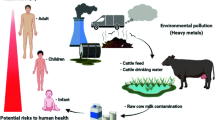Abstract
The study of the composition of human milk has attracted world-wide interest, since it represents the pattern of nutrients most suitable for the younger infant. In the present study, the concentration of Ca, Mg, Fe, Cu, and Zn was measured in a total of 211 samples of human milk. The analytical technique of inductively coupled plasma atomic emission spectrometry (ICP-AES) was used for the analysis. From the results, it indicates that the mean concentration of Zn is highest in the colostrum with decreasing concentrations as the lactation progressed. The effects of age, parity, and lactation history on the results are also analyzed. It shows that the Zn concentration in the colostrum in the older mothers (>30 yr) was higher than that of the younger ones (20–30 yr).
Similar content being viewed by others
References
A. Flynn, Minerals and trace elements in milk,Adv. Food Nutr. Res. 36, 209–252 (1992).
H. Robberecht, H. Benemariya, and H. Deelstra, Daily dietary intake of copper, zinc, and selenium of exclusively breast-fed infants of middle-class women in Burundi, Africa,Biol. Trace Element Res. 49, 151–159 (1995).
G. B. Fransson and B. Lonnerdal, Iron, copper, zinc, calcium, and magnesium in human milk fat,Am. J. Clin. Nutr.,39, 185–189 (1984).
C. E. Casey, K. M. Hambidge, and M. C. Neville. Studies in human lactation: zinc, copper, manganese and chromium in human milk in the first month of lactation,Am. J. Clin. Nutr. 41, 1193–1200 (1985).
A. Gharib, H. Rahimi, H. Pyrovan, N. J. Raoffi, and H. Taherpoor, Study of trace elements in milk by nuclear analytical techniques.J. Radioanal. Nucl. Chem. Articles 89, 31–44 (1985).
J. T. Bond, L. J. Filer, Jr., G. A. Leveille, A. M. Thomson, and W. B. Weil, Jr.,Infant and Child Feeding, Academic, New York (1981).
Committe on Nutrition, American Academy of Pediatrics, Commentary on breastfeeding and infant formulas including proposed standards for formulas.Nutr. Rev. 34, 248–256 (1976).
K. S. Lin, Y. J. Jong, C. H. Chiang, and S. M. Lin, Calcium, magnesium, copper, zinc and iron contents in human and cow's milk,Acta Paediatr. Sinica 27, 106–113 (1986).
V. S. Packard,Human Milk and Infant Formula, Academic, New York (1982).
E. J. Underwood,Trace Elements in Human and Animal Nutrition 4th ed. Academic, New York (1977).
L. Perrone, L. Palma, R. Toro, G. Gialanella, and R. Moro, Trace element content of human milk during lactation,J. Trace Element Elect. Health Dis. 7, 245–247 (1993).
J. Arnaud, A. Prual, P. Preziosi, F. Cherouvrier, A. Favier, P. Galan, et al., Effect of iron supplementation during pregnancy on trace element (Cu, Se, Zn) concentration in serum and breast milk from Nigerian women,Ann. Nutr. Metabol. 37, 262–271 (1993).
U. M. Saarinen, M. A. Siimes, and P. R. Dallman, Iron absorption in infants. High bioavailability of breast milk as indicated by intrinsic tag method of iron absorption and by concentrations of serum ferritin.J. Pediatr. 91, 36–39 (1977).
U. M. Saarinen and M. A. Siimes, Iron absorption from infant milk formula and the optimal level of iron supplementation,Acta Paediatr. Scand. 66, 719–722 (1977).
P. E. Johnson and G. W. Evans, Relative zinc availability in human breast milk, infant formulas and cow's milk.Am. J. Clin. Nutr. 31, 416–421 (1978).
Author information
Authors and Affiliations
Rights and permissions
About this article
Cite this article
Lin, TH., Jong, YJ., chiang, CH. et al. Longitudinal changes in Ca, Mg, Fe, Cu, and Zn in breast milk of women in Taiwan over a lactation period of one year. Biol Trace Elem Res 62, 31–41 (1998). https://doi.org/10.1007/BF02820019
Received:
Revised:
Accepted:
Issue Date:
DOI: https://doi.org/10.1007/BF02820019




